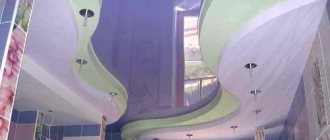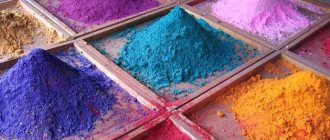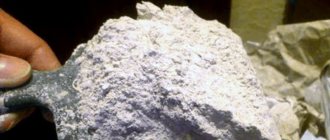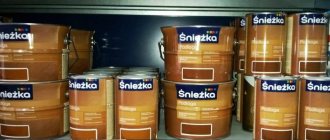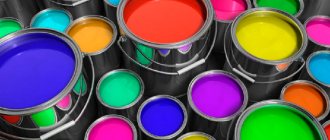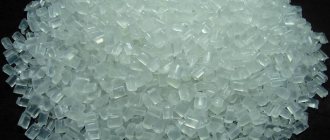Types and description of material
Acrylic base comes in different varieties. It is recommended to consult with a specialist and explain to him well what you want to see after painting the walls. It will easily help you choose the right option.
The following types of paint are distinguished:
- Glossy . It gives the walls shine. The surface on which the paint will be applied must be smooth and free from flaws. If the surface has defects, everything will be visible after painting.
- Matte . This type is suitable for long-term finishing. Even after time, the painted surface will remain in the same form.
- Mother of pearl . This is a special type of material for wall decoration. It contains a special filler. After using this type of liquid base, the painted area will acquire the effect of a relief surface.
- Water-based . It is not as durable as other acrylic coatings. This emulsion is made on a water basis.
The types of paint are not limited to this. For example, there is also washable wall paint, which is very suitable for bathrooms and other wet areas.
One of the important advantages of acrylic emulsions is that you can work with these paints at any time of the year.
If you want to save a little on paint during repairs, then apply primer to the surface before processing.
Acrylic wall paints come in a variety of colors. But if you want to slightly change the main shade, then you need to add white to the main emulsion. This way the color will become less bright, soft, delicate and pleasant. You can do this yourself or contact a specialist.
Types of acrylic coatings
Depending on where acrylic paint is used, it is divided into the following types:
- external;
- internal;
- automobile;
- used in painting.
The façade acrylic coating contains substances and additives that improve its resistance to sunlight, moisture and abrasion. This paint can be used to cover facades, fences, benches, gates and other external surfaces.
Interior paints have less resistance to external irritants, but they work well. Interior finishing paints are available separately for walls and ceilings. Universal compositions with acrylic have also been developed, suitable for both indoor and outdoor work.
Depending on the additional functions of acrylic paints, there are:
- lightfast;
- moisture resistant;
- well-tolerant of mechanical stress;
- washable.
Such acrylic coatings can still have a beautiful shine. In this regard, the following paints are distinguished:
- glossy;
- matte;
- silky matte;
- semi-gloss.
Methods of dilution and application
When thinning paint, it is important to ensure that it retains its gloss or matte structure. At home, the emulsion is diluted with water. Water is usually added at 10%. If you paint with a spray gun, then it is necessary to dilute the paint.
There is nothing complicated about painting. The main thing is that the walls are well prepared. The liquid material must be applied to the surface in a diluted form. It doesn't take long to dry, it takes about half an hour. When applying, use brushes, rollers or a spray gun.
Acrylic for wall painting
The undoubted advantage of acrylic paints is the ability to work with them in any weather conditions, which is especially important when painting walls and facade work.
In this case, acrylic paints and acrylic relief pastes can be used to create a unique and original design.
Acrylic paints also performed well in impasto painting. But it should be remembered that for such work, acrylic paint is not diluted with water, but with a special solvent, which can be produced either by the manufacturer or by a third-party company.
Acrylic paint cost
The price most often depends on the manufacturer and volume. There are acrylic products for application to walls, which are sold in tubes. They are small in volume and are mainly used by artists for decoration. And for construction work they use emulsions in jars. They are much larger in volume. There are even emulsions in the form of aerosols, but you can’t find them in hardware stores. Use aerosols only for small or decorative elements.
Thus, the cost of an acrylic composition usually ranges from 170 rubles to 300 rubles, weighing from one to five kilograms. The more kilograms a jar contains, the more expensive it is.
It’s not just volume that plays a decisive role. Much depends on the quality of the applied material. The cheapest options are of lower quality, and the most expensive ones are the opposite. But you shouldn’t pay too much attention to the price and trust only acrylic options with a high price tag. Often the price depends on the popularity and demand of the manufacturer in the market, as well as on its advertising activities. It is better to opt for trusted manufacturers with average price products.
Before purchasing the main material, you can stock up on the necessary information on the forums by reading reviews. But it’s best to consult with a specialist or ask a sales consultant at a hardware store in more detail.
Price
Below are prices for high-quality acrylic paints from some well-known manufacturers (current for spring 2021):
| Brand | Cost in rubles |
| Belinka 10 l (facade) | 4 200 |
| Finncolor Oasis Hall & Office 1 l (moisture resistant, but not washable) | 235 |
| Parade W3 10 l (interior moisture resistant) | 1 400 |
| Tikkurila Luya 40 1 l | 880 |
| Dulux Lux Aqua 40 (glossy for interior use) 2.3 l | 1 750 |
Best places to buy
If you want to buy a quality product, then, of course, it would be better to visit a special hardware store. There the paint will cost a little more than on the market. But you will be sure that you bought a good product. Having bought cheap paint on the market, there is no guarantee that you won’t have to repaint the walls again.
Do not forget that a low-quality product will immediately make itself felt. It will take a long time to dry, lay down unevenly, and cracks or lines may appear. And the painted surface itself will have a completely unattractive appearance. To prevent this from happening, the choice of material should be approached with the utmost seriousness.
Acrylic water-dispersion paint: characteristics
Acrylic paints are water-dispersed paints, the base for which is polyacrylates and their copolymers, which serve as film formers. Paint consists of three components:
– color pigment; – acrylic polymer emulsion; - water.
The advantages of this paint include:
- fast drying process;
- a good covering surface, so that they do not fade or become dull over time;
- the brightness of the paint, which practically does not change over time;
- the formation of a resistant film after drying, as a result of which the paint is resistant to high temperatures, and cracks and wrinkles do not form on it.
The range of applications of such paints is wide; they are used both in artistic crafts (drawings with acrylic paints on the wall) and in construction (for interior and exterior work).
Material consumption per 1 sq. m
Usually one can of material is enough for 3.5-4.5 square meters of wall. But the cost may depend on the performance of the work itself. If the painting is done poorly, each area is painted poorly and unevenly, leaving gaps, then much less paint will be used. But don’t forget that you can’t save on paint. The more acrylic liquid is applied to the wall, the better and more uniform the surface will look. All gaps will be filled and shortcomings will be hidden.
Don't forget to be careful while working. Most craftsmen do not think about saving material; they waste it, spilling large amounts on the floor or on things. Thus, the process is significantly speeded up, but the speed of completing the work does not mean that the work is done well. Moreover, most of the acrylic paint was spilled in vain.
You should also pay attention to the features of the material itself. Some manufacturers produce thicker acrylic liquids, others less. It is more profitable to use thick ones, since they can be easily diluted to the desired consistency. Liquid options will flow and adhere poorly to the surface.
How to choose the right composition
If necessary, water-dispersed acrylic paint is easily diluted with water.
To independently choose a coloring composition that will create a durable and high-quality coating, you should listen to the advice of builders and designers:
- To paint a living room, office, children's or bedroom, you can buy water-based or water-dispersion paint without any additives. This material creates a breathable coating, dries quickly, and does not release harmful compounds into the environment.
- For rooms with high humidity - bathrooms and kitchens - it is advisable to choose acrylic compositions with the addition of latex or silicone. The presence of these components will provide the coating with resistance to moisture, splashes, drops of water and detergents. The same type of paint is recommended to be applied in hallways and corridors. In these rooms, the walls have to be washed frequently, as they become dirty from constant contact with outer clothing and street shoes.
When choosing an acrylic-based paint and varnish material, you need to consider not only its type, but also its purpose:
- To paint interior walls and ceilings, you need to use interior paint (for interior work).
- House facades, external and internal walls of unheated utility buildings, garden sculptures and other architectural forms should be painted with compounds for facade or exterior work.
Manufacturers offer a rich palette of shades. But if the color of the finished product is not suitable for the design of a kitchen, bathroom or living room, you can buy white water-based paint and tint it in one color or another. Almost all companies and stores selling building materials provide tinting services for paints and varnishes.
You can give the suspension the desired shade yourself - just purchase a coloring pigment and mix it thoroughly with the white base. Experts advise adding color in small portions until the mass is painted in a shade that matches the design intent. The final color of the painted surface depends on the degree of initial whiteness of the coloring composition.
According to the level of whiteness, acrylates are divided into 3 categories:
- super white;
- white;
- milky white.
Super white paints give a shining, snow-white shade, so they are better suited than others for painting ceilings or tinting. When buying paint and varnish material, you should make sure that the inscription on the container corresponds to reality.
To avoid a discrepancy between what is indicated on the packaging and the actual shade, before paying with the seller, you need to compare the color of the suspension with stationery paper (you can take an A-4 sheet with you to the store or to the construction market).
There is another type of acrylic paint - structural, or texture. It can be applied to external and internal walls, and used to protect surfaces exposed to climatic and mechanical stress.
With the help of available materials and construction tools, on a freshly painted surface, you can create an imitation of finishing from various materials: concrete, natural stone, natural leather, wood eaten by bark beetles, etc.
Matte acrylic paints are most often used for painting walls in bedrooms and children's rooms.
Gloss or matte finish
When applied to walls and ceilings, acrylic compounds can form a matte or glossy finish. Matte paint will create a warm, cozy atmosphere, visually expand the space, give the surface a velvety texture, and hide minor defects. However, stains of dirt and grease will be clearly visible on a matte wall, so it will have to be washed frequently.
Glossy paint and varnish material will make the walls shiny and the interior presentable. It will mask traces of splashes and water drips, but will reveal all the unevenness and roughness.
Before applying such a composition, you will have to carefully prepare the base and remove the slightest defects. But it will be much easier to care for a glossy wall than a matte one.
Acrylic water based
Compared to watercolor or oil paints, water-based acrylic paint has a number of advantages, including versatility, ease of use, and enormous popularity in construction and renovation work.
Such paints are used mainly for interior decoration, since water-based acrylic paints are durable and water-resistant.
After this paint dries, a film forms on the item, so the decorated piece of furniture can be washed and wiped. It should be noted that water-based acrylic paints do not have a strong odor, so even children prone to allergies can use them.
Wallpaper is a great alternative to paint. To learn how to line walls with wallpaper, follow this link.
The most budget option is paper wallpaper. Read about them in this article.
If you don't know whether you can hang wallpaper in winter, go here.

